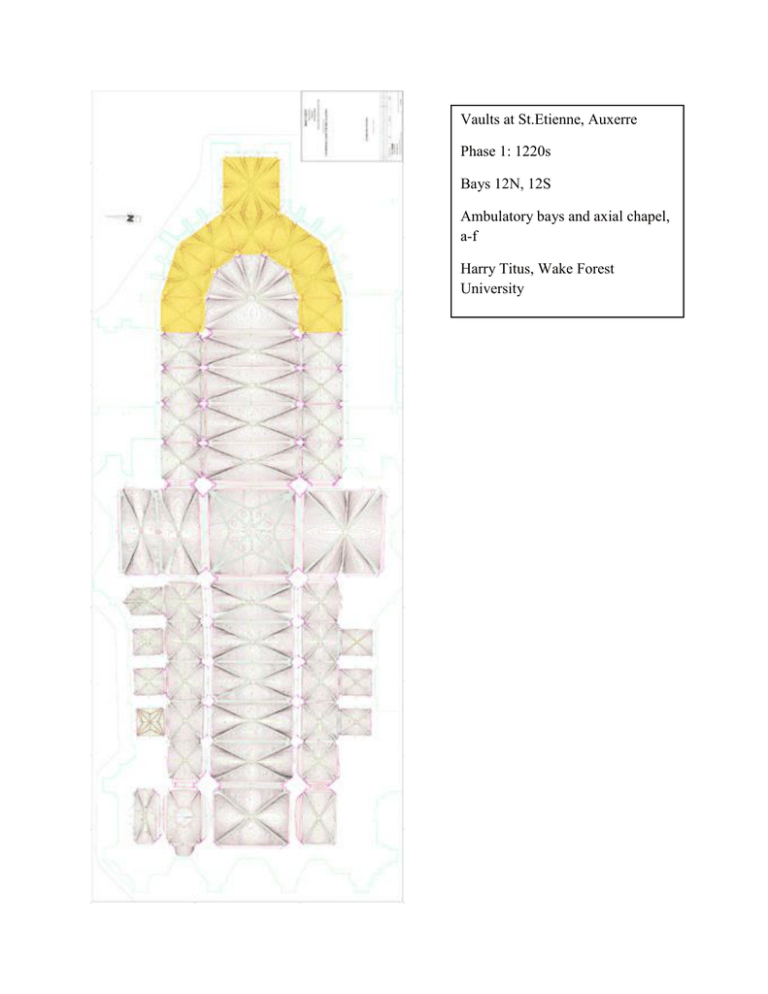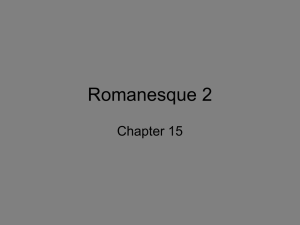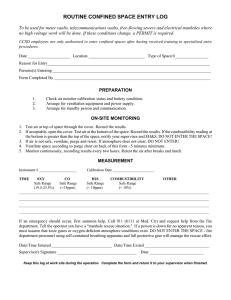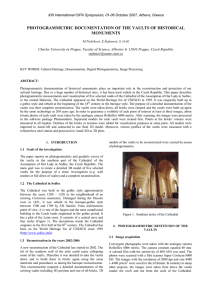Vaults at St.Etienne, Auxerre Phase 1: 1220s Bays 12N, 12S
advertisement

Vaults at St.Etienne, Auxerre Phase 1: 1220s Bays 12N, 12S Ambulatory bays and axial chapel, a-f Harry Titus, Wake Forest University Documentary evidence found in the account of Bishop Guillaume de Seignelay’s life in the so-called Gesta recounts a collapse in 1217 of paired towers related to the cathedral’s Romanesque chevet. The collapse occurred when bells were rung while the towers were braced. The towers were slated to be retained while a new, updated sanctuary was constructed. After the collapse of the towers the new construction program was evidently amplified westward to the scale and extent existing today. The chevet side aisle/ambulatory vaults falls into two distinct groups, the first of which is discussed in this section. The relative dating is meant to suggest that these vaults were the first to be constructed in the Gothic cathedral. Vaulting phase 1 consists of the vaults in the axial chapel, plus the ambulatory vaults through the first straight bays of the side aisles, a total of 8 vaults (12n, 12s, a-f). This group corresponds to the sanctuary program, ending at the west at the large compound pier defining the entrance to the hemicycle. The axial chapel (f) is something of a special case, since its plan, and the overall plan of the chevet, are constrained by the plan of the pre-existing Romanesque crypt. However, the axial chapel is square in plan, as opposed to the rectilinear crypt chapel beneath it. The upper walls were pushed out to exterior limit of the crypt and slightly beyond, set above new encasing masonry to support the thin axial chapel walls. The 13th-century designer did not choose to bridge the resulting wide gap at the entrance to the axial chapel, nor did he choose to erect an axial column to reduce the arch and vault span. His solution was to divide the perimeter walls of the turning bays into thirds, which allowed him to emphasize a slender verticality in his parti while reconciling the difference between the radii of the hemicycle with the polygonal exterior walls. The turning bays are covered by 6-part vaults, but not 6-part vaults as they are normally construed. These vaults are essentially 4-part vaults with the exterior voutain divided into three parts by 2 ribs supported on the exterior wall by responds that frame each exterior window unit. The designer chose to place the keystone in the middle of the bay unit, adjusting the rib directions as necessary. Thus, the hemicycle piers and the outer wall are adroitly connected into a system. The axial chapel, then, has three windows on its flat east wall, two windows each on its north and south walls, and opens into the ambulatory to its west through three openings separated by two spectacularly slender en-délit columns. It is covered by a 10-part vault; three voutains on the east and west, and 2 voutains on the north and south. Its nature demonstrates Viollet-leDuc’s contention that the ribbed vault is essentially a collection of small vault compartments, or voutains. The vault is isolated from the peripheral wall surface by a slot of space created by a dado level interior passageway that is covered by flat lintels where it passes through the responds. This parti continues through the turning bays of the chevet and through its side aisles. The entire axial chapel-chevet aisle ensemble is a tour de force of design whose innovative qualities cannot be overstated. The axial chapel vault was resurfaced on its intrados during one of the modern programs of restoration in the chevet. Its web is not visible as it is hidden by a layer of greyish surfacing material. The contour drawing for this bay is so symmetrical that it may reflect this surfacing as much as it does the web itself. A feature to note is the flatness of the voutain upper sections close to the keystone. The vault crowns rise an average of 32 cm from exterior points above the windows to the keystone. Both the design and execution of this vault were adept adaptations to the square chapel with differing elevation elements. The vaults in the chevet ambulatory bays (a-e) are noteworthy in that they were constructed with the flattest crowns of any of the cathedral vaults. In general, the contour drawings show that the vaults were built in a consistent manner up to the sanctuary compound piers, that is, 7 vaults total. The consistency of the contours is especially striking in the longitudinal sense in these bays. The vault crowns at the bay arches are within 1 cm in this sense, while in the transverse direction, the inner voutain crowns are consistently 60 cm higher than those in the exterior voutains, which visibly slope downward toward the exterior responds. The side to side difference was caused by a small change in parti between the ambulatory hemicycle piers and the exterior wall. The wall arches on the exterior are semicircular, while the more closely spaced arches between the hemicycle piers are pointed. The vaulting strategy facilitated adjustments that were caused by the difference in distance spanned by the inner and the outer elements in the turning bays. At the west, in the straight bays of the ambulatory (12n, 12s) the inner voutain crown is slightly twisted to account for the larger size of the sanctuary compound pier. Overall, there is consistency within a tolerance of 5 cm in the development of major elements in this group of vaults. The axial ambulatory bay (c) has an extremely flat crown that is not found elsewhere in the cathedral. Its neighbor to the north (b) is almost as bold. It seems possible to argue that these two vaults form a sub-group within this program. A second sub-group would consist of the remaining three turning bay vaults, with the two straight bay vaults in the third sub-group. Here we encounter an interpretive problem; this phase of vaulting is quite consistent, but there are slight but recognizable differences in practice within the group. Are we seeing different gangs of masons at work, or is there a small time difference between sub-phases?






